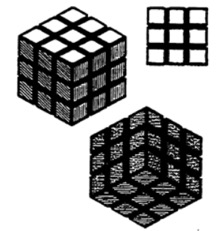Discussion: Court of Justice of the European Union; November 10, 2016, Case 30/15, Simba/EUIPO (full text here).
In this case the CJEU could further clarify how to apply the rule of European trade mark law providing that trade marks that consist exclusively of a shape or other characteristic of a product that is necessary to obtain a technical result cannot be protected. The decision is interesting for South African trade mark law, since section 10(5) of the Trade Marks Act contains an almost identical rule.
Simba, a toy manufacturing company, requested the European Intellectual Property Office (EUIPO) to invalidate a registration of the following trade mark registered for three-dimensional puzzles in the name of Seven Toys, on the basis that the mark consists exclusively of a shape necessary to obtain a technical result.

One recognizes the contours of the famous Rubik’s Cube puzzle.
EUIPO rejected the claim and so did the Board of Appeal. A further appeal was lodged with the General Court, but that appeal was rejected as well. However, the appeal to the CJEU was successful. The CJEU repeated prior case law saying that for the functionality exception to apply one first has to assess what the essential characteristics of the mark are. Everybody agreed that the essential characteristics at issue are a cube and a grid structure on each surface of the cube. Simba argued that the black lines and, more generally, the grid structure on each surface of the cube perform a technical function.
The General Court said that this argument was essentially based on knowledge of the rotating capability of the vertical and horizontal lattices of the ‘Rubik’s Cube’ and that that capability cannot result from the characteristics of the shape presented but, at most, from an invisible mechanism internal to that cube. The General Court held that the Board of Appeal was right not to include that invisible element in its analysis of the functionality of the essential characteristics of the contested mark. In that context, the General Court took the view that inferring the existence of an internal rotating mechanism from the graphic representations of that mark would not have been consistent with the requirement that any inference must be drawn as objectively as possible from the shape in question, as represented graphically, and with sufficient certainty.
This reasoning was rejected by the CJEU. After having reminded us of the rationale behind the functionality exception, being that it seeks to prevent trade mark law from granting an undertaking a monopoly on technical solutions or functional characteristics of a product, the CJEU said that the essential characteristics of a shape must be assessed in the light of the technical function of the actual goods concerned. Thus, and since it is not disputed that the sign at issue consists of the shape of actual goods and not of an abstract shape, the General Court should have defined the technical function of the actual goods at issue, namely a three-dimensional puzzle, and it should have taken this into account when assessing the functionality of the essential characteristics of that sign. The CJEU added that while it was necessary for the purpose of that analysis to proceed on the basis of the shape at issue, as represented graphically, that analysis could not be made without taking into consideration, where appropriate, the additional elements relating to the function of the actual goods at issue.
The lesson to be drawn from this decision (as well as from earlier decisions of the CJEU) is that whatever the representation of a product and/or the description in the registration is, the possible functionality of the essential characteristics needs to be assessed also on the basis of a detailed examination that takes into account material relevant to identifying appropriately the essential characteristics of a sign.
It seems though that taking into account factors other than those that follow from the registration itself is at odds with the legal certainty of the register. However, the rationale of the functionality doctrine (avoiding monopolizing technical solutions by trade marks) dictates that efforts are being made to avoid circumvention of the rationale by claiming such solutions in shrewd registrations.

